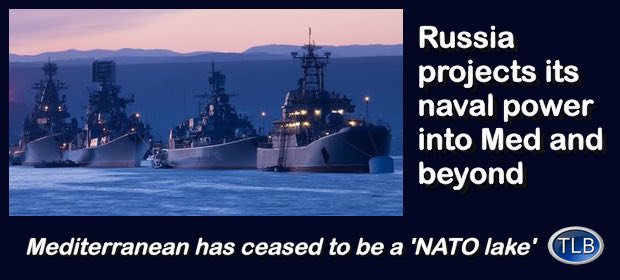
Russia’s Navy Establishes Permanent Presence in Mediterranean Sea
PETER KORZUN
Russian President Vladimir Putin has said that a naval standing force, including warships with Kalibr long-range land attack cruise missiles, will be permanently deployed in the Mediterranean Sea. The statement was made at a meeting with top military officials and defense industry leaders that took place in Sochi on May 16. One of the missions is  delivering strikes against terrorist targets in Syria. 102 expeditions of ships and submarines are planned in 2018. The force will go through intensive training.
delivering strikes against terrorist targets in Syria. 102 expeditions of ships and submarines are planned in 2018. The force will go through intensive training.
The Russian Black Sea Fleet has become a much different force in comparison to what it was just three years ago. Since 2015, the year the operation in Syria was launched, it has acquired 15 new ships, including two frigates and six conventional submarines armed with Kalibr cruise missiles. With S-400 and S-300V4 air defense systems, Krasukha-4 electronic warfare systems and shore-based anti-ship Bastion batteries deployed on the Syrian coast, the ships in the eastern Mediterranean operate in a relatively safe environment. Kalibr missiles have already been fired from frigates and submarines at terrorist targets in Syria.
Last July, a 15-strong Mediterranean Task Force was established to be based out of Tartus, Syria’s leased naval facility. The ships provide a buffer on the southern flank of NATO. Russia needs to counter aggressive activities of the bloc in the region, including the Black Sea. Maintaining a robust presence in the Mediterranean is the best way to defend Russia’s Black Sea borders.
All of southern Europe, including such NATO military assets as Allied Joint Force Command in Naples, Italy, Combined Air Operations Centers in Larissa, Greece, and in Poggio Renatico, Italy, Headquarters Allied Land Command and Air Power Command in Izmir, Turkey, NATO Incirlik air base in Turkey, Graf Ignatievo and Bezmer air bases in Bulgaria used by US Air Force, as well as a lot of other key NATO defense infrastructure sites, happen to be within the range of Kalibr missiles installed on the platforms patrolling the Mediterranean Sea. They’ll all be knocked out with first salvos in case a Russia-NATO war starts.
The Fleet’s operations are not limited to the Black Sea basin and the Mediterranean. It is on the way of transition from a green-water naval formation to a blue water force, demonstrating the Russian flag as the ships move beyond the Strait of Gibraltar and the Suez Canal on the way to the World Ocean.
The establishment of a permanent naval presence in the region can be explained by a number of rational calculations. The Mediterranean Sea is Russia’s only exit to the open ocean for the Black Sea Fleet. The permanent presence is a logical step in view of Russia’s growing political influence in the Middle East and North Africa (MENA).
Foreign Ministries are not the only ones to shape external policy. Any port call is a diplomat mission, providing an opportunity for official meetings and public diplomacy, with the events covered by media. Take the famous German Kiel Week or Kieler Woche in German, the biggest annual maritime festival and international forum visited by about three million people coming from all over the world. Warships from many countries are an important element of the event. Ships also take part in the Irish maritime festival at Drogheda Port. Russian frigate The Shtandart, a replica of the man-of-war built by Peter the Great in 1703, will visit Drogheda on June 10-11 this year.
The naval visits reflect foreign policy trends. In 2017, Russian ships made 46 port calls to drop anchor at 28 ports of 27 countries worldwide. The list includes five Western or West-friendly states: Greece, Portugal, Cyprus, Japan and South Korea, which account for 19% of the countries visited by Russian ships. Nine (33%) of the states on the list belong to the Asia-Pacific region, with other 13 (48%) situated in Africa, the Middle East and South Asia. The 81% vs.19% ratio illustrates Russia’s rebalancing from the “collective” West toward other countries and power poles. The Russian Navy also conducted six international exercises, demonstrating its global presence and power projection capability.
Growing global trade brings to the fore the task of protecting critical sea lanes. Russia has longstanding economic ties with many Mediterranean states, including Greece, Libya, Cyprus, and Algeria. The relations include defense cooperation.
US Navy deployments in support of ballistic missile defense are viewed as provocative moves to downgrade Russia’s strategic nuclear capability. With Russia’s continuous presence in the region, Aegis ships as well as aircraft carriers become sitting ducks for state-of-the art anti-ship missiles.
Like it or not, the Mediterranean Sea has ceased to be a “NATO Lake” dominated by US 6th Fleet. American vessels don’t own these waters anymore. As a great power, Russia has its own interests in the region and it has a powerful naval force permanently deployed to defend them.
************
Original article
ER recommends other articles by Strategic Culture Foundation




